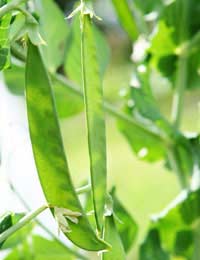
Beans – or legumes – are an excellent source of protein, and well worth giving some space in your vegetable garden. They’re very useful in vegetarian cooking, as they provide a cheap and easy source of protein (many contain more, gram for gram, than steak) – and to top it all off, legumes can be kept in store for months. Here are tips for growing and cooking with legumes.
Growing Beans – Tips For Success
Beans are greedy growers, and they like to be kept warm. So, before any seeds go in the ground, incorporate well-rotted manure, home compost, or dig a trench (at least 30cm deep) and put in a layer of kitchen waste (like vegetable peelings). Sow after the last frost in your area, sowing some extras at each end of your rows as insurance against seeds that don’t germinate. The packet will have sowing distances, which are typically around a foot (30cm). It may be a good idea to sow some seeds under cover, especially if you want a head start (and your legumes are expected to need a long growing season). Check the growing instructions to see how tall your beans will grow. Climbing Beans are self-supporting, winding themselves up poles or hazel sticks. Erect a wigwam or a row of poles, connected with a horizontal pole that’s tied in with string. When the beans start to flower, make sure their roots don’t dry out. To dry and store your legumes, read our article about Drying Beans and Pulses.
Cooking With Dried Beans
Now you have a crop of beautifully maroon-coloured beans, stippled Borlotti beans or creamy-white cannellini beans, you’re wondering what to do with them. Here are some tips and recipes.
If they’re dried, you’ll need to pre-soak the legumes, whichever type they are. This pre-soak helps them to cook more quickly. Next, drain and then cover them in fresh, boiling water (no salt) – you can add onion, garlic or herbs to the cooking water if you like. Bring to a rapid simmer, and let your beans bubble hard for 10 minutes. This eliminates any toxins that may be stored in them. Now reduce the heat to a very gentle simmer, cover the pan, and cook until the beans are tender. This takes 30 minutes to 2 hours, so you’ll have to keep a close eye on your first batch.
When they are tender, add them to soups or stews, blend them into hummous-style dips, or stir into stewed tomatoes and sprinkle with coriander as a delicious peasant-style dinner.
An Idea For White Beans
In Greece, cannellini, haricot and butter beans are slowly stewed to make a vegetarian bean salad (Fasoulia). Put your soaked and drained beans into a heavy casserole pan – use enough to make a single layer in the bottom – and pour over enough olive oil to come halfway up them. Bring to a gently puttering simmer and put on the lid, then turn the heat to low. After ten minutes add a cup of water or stock, two or three peeled cloves of garlic, a bay leaf, and two tablespoons of sun dried tomato puree. Cook on a low heat for another 40-60 minutes, or until the beans are tender. Season with salt, pepper and lemon juice and serve warm or cold.
An Idea for Chili or Black Beans
Dark-coloured beans (black, maroon or black-eyed) are traditionally used in Caribbean and Brazilian cookery. One favourite dish is Rice’n’Peas, which is as simple as it sounds – but far more delicious! Soften an onion with some garlic in a pan, add your soaked beans, a few sprigs of fresh thyme, a chili (optional), and some stock, and cook until the beans are perfectly tender. Stir in a can of coconut milk, and serve over rice. Black beans also make a delicious vegetarian chili – add plenty of tomatoes and chipotle chili is, and stand well back!
